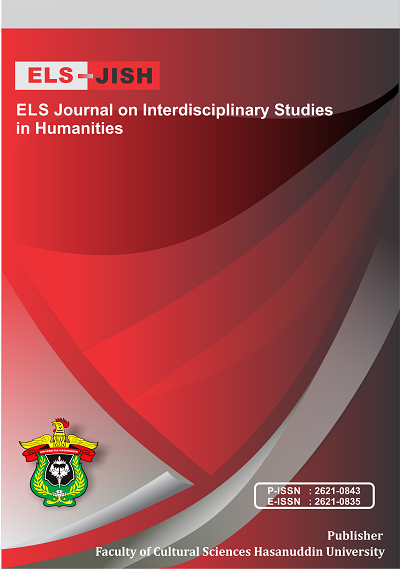Satire and Sarcasm on the “YouTube Got Talent" Video: A Case Study on Skinnyindonesian24 Channel
DOI:
https://doi.org/10.34050/elsjish.v5i2.21725Keywords:
Language style, satire, sarcasm, YouTubeAbstract
The specialty of the satire language style can be seen through the use of figurative words in it. The more a person is able to use words, it is able to create a special impression when telling someone who is the target of the satire. This study aims to describe the forms and functions of satire and sarcasm in the video content SkinnyIndonesian24 "YouTube's Got Talent". The method used is a qualitative descriptive research method. The data was obtained by using the free-of-conversation (SBLC) listening technique using Gorys Keraf's theory. The results obtained in this study are 29 satirical satire language styles that satirize YouTubers, Netizens, and the YouTube algorithm, and 7 sarcasm styles that satirize YouTubers, Netizens and the jury. The function of the satire language style is 9, and the sarcasm style is 4. Based on the data that the writer finds, the satirical style of satire seems to be more dominant than the sarcasm style. However, it has many of the same functions that are as opinion delivery.
References
Abulaish, M., Kamal, A., & Zaki, M. J. (2020). A survey of figurative language and its computational detection in online social networks. ACM Transactions on the Web (TWEB), 14(1), 1-52.
Aminuddin. (2008). Semantik Pengantar Studi Tentang Makna. Bandung: Sinar Baru Agensindo.
Chaer, A., & Agustina, L. (2010). Sosiolinguistik: perkenalan awal. Penerbit PT Rineka Cipta.
Cheang, H. S., & Pell, M. D. (2008). The sound of sarcasm. Speech communication, 50(5), 366-381.
Fadhal, S. dan Nurhajati, L.(2012). Identifikasi Identitas Kaum Muda di Tengah Media Digital, Studi Aktivitas Kaum Muda Indonesia di Youtube. Jakarta: Universitas Al-Azhar Indonesia.
Fairuz, Rahman, F., & Amin, M. A. (2022). Authors’ Figurative Expressions From Two Novels: A Comparative Analysis Between RTJNA Rosso and RTJNA Blu. Theory and Practice in Language Studies, 12(1), 150-157.
Halimah, S. N., & Hilaliyah, H. (2019). Gaya bahasa sindiran Najwa Shihab dalam buku catatan Najwa. Deiksis, 11(02), 157-165.
Hariyanto, D.F.(2017). Penggunaan Gaya Bahasa Sarkasme pada Film The Raid: Berandal. Skripsi. Mataram: Program Studi Bahasa dan Sastra Indonesia, FKIP Universitas Mataram.
Haberland, H., & Mortensen, J. (2012). Language variety, language hierarchy and language choice in the international university. International Journal of the Sociology of Language, (216), 1-6.
Irfan, M.F. ( 2019). Analisis Gaya Bahasa Sindiran dalam Akun Twitter Ustadz Tengku Zulkarnain. Skripsi. Malang: Program Studi Pendidikan Bahasa dan Sastra Indonesia, FKIP Universitas Muhammadiyah Malang.
Keraf, G. (2010). Diksi dan Gaya Bahasa. Jakarta: Gramedia Pustaka Utama.
Kovacs, B., & Kleinbaum, A. M. (2020). Language-style similarity and social networks. Psychological science, 31(2), 202-213.
Kridalaksana, H. (2013). Kamus Linguistik. Jakarta: Gramedia Pustaka.
Machin, D., & Van Leeuwen, T. (2005). Language style and lifestyle: the case of a global magazine. Media, Culture & Society, 27(4), 577-600.
Montgomery, M. (2008). An introduction to language and society. Routledge.
Murti, S. (2013). Kajian Stilistika Cerpen Rumah Bambu Karya YB Mangun Wijaya dan Implikasi terhadap Pembelajaran Sastra di SMA (Doctoral dissertation, Universitas Mataram)
Nurgiyantoro, B. (2019). Stilistika. Yogyakarta: Gajah Mada University Press.
Onan, A., & Toçoğlu, M. A. (2020). Satire identification in Turkish news articles based on ensemble of classifiers. Turkish Journal of Electrical Engineering and Computer Sciences, 28(2), 1086-1106.
Prasetyono, D. S. (2011). Buku Lengkap Majas dan 3.000 Pribahasa. Yogyakarta: Diva Press.
Ratna, N.K. (2013). Stilistika Kajian Puitika Bahasa Sastra dan Budaya.Yogyakarta: Pustaka Pelajar.
Rahman, F. (2014) Iconic Forces of Rhetorical Figures in Shakespeare's Selected Drama. Dissertation (unpublished), Hasanuddin University.
Rahman, F. (2016). The Strategy of Teaching Literature through Language-based Methods: A Communicative Approach. In Annual Seminar on English Language Studies (1), pp. 156-170).
Rahman, F., & Weda, S. (2019). Linguistic deviation and the rhetoric figures in Shakespeare’s selected plays. XLinguage" European Scientific Language Journal", 12(1), 37-52.
Ravi, K., & Ravi, V. (2017). A novel automatic satire and irony detection using ensembled feature selection and data mining. Knowledge-Based Systems, 120, 15-33.
Ritchie, D. M. (1993). The development of the C language. ACM Sigplan Notices, 28(3), 201-208.
Saleh, F., Rahman, F., & Hasyim, M. (2021). Metaphor in the Bugis Language Expression of the Sidenreng Dialectin South Sulawesi. International Journal of Arts and Social Science, 4(1), 312-318.
Said, M. M., Rita, F., Weda, S., & Rahman, F. (2021). English Language Performance Development Through Extracurricular Activities At Faculty Of Teacher Training And Education Tadulako University Palu. PalArch's Journal of Archaeology of Egypt/Egyptology, 18(08), 388-403.
Snickars, P., & Vonderau, P. (2009). The youtube reader. Kungliga biblioteket.
Sukmawaty, Rahman F. F., Andini, C. (2022). Covid-19 Pandemic and Axiology of Communication: A Study of Linguistic Phenomena. International Journal of Innovative Science and Research Technology 7(4), 2456-2165.
Susilo, S.S.W. (2020) Gaya bahasa Simile, Metafora, dan Satire dalam akun instagram Nanti Kita Cerita Tentang Hari Ini Unggahan Februari - Desember 2018. Skripsi thesis, Sanata Dharma University.
Suwito. (1983). Pengantar Awal Sosiolingustik: Teori dan Problema. Surakarta: Fakultas Sastra Universitas Sebelas Maret.
Tarigan, H. G. (2013). Pengajaran gaya bahasa. Bandung: Angkasa.
Tuloli, N. (2000). Kajian sastra. Gorontalo: BMT “Nurul Jannah.
Waluyo, H.J.( 2002). Pengkajian Sastra Rekaan. Salatiga: Widyasari Press.
Wardani, R.E. (2019). Sarkasme dalam Berbahasa pada Kehidupan Sehari- Hari Di Wilayah Kabupaten Kendal (Kajian Sosiologi). Skripsi. Semarang. Program Studi Pendidikan Bahasa dan Sastra Jawa. FBDS Universitas Negeri Semarang.
Downloads
Published
How to Cite
Issue
Section
License
Copyright (c) 2022 Kasno Atmo Sukarto, Fachrizah Fauziah

This work is licensed under a Creative Commons Attribution-NonCommercial-ShareAlike 4.0 International License.






